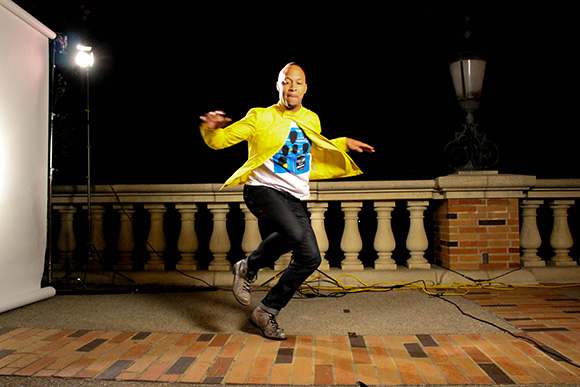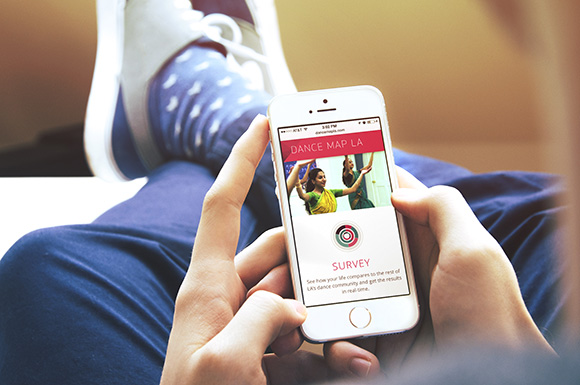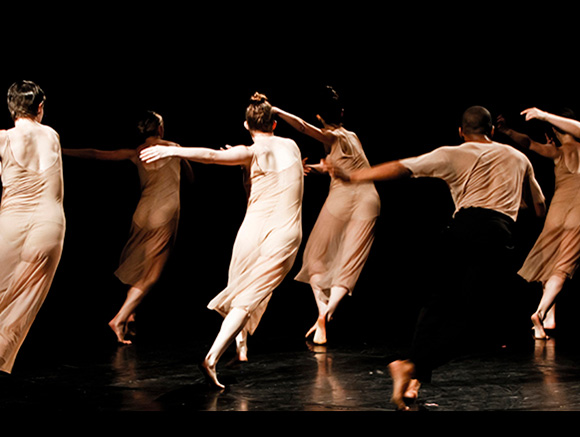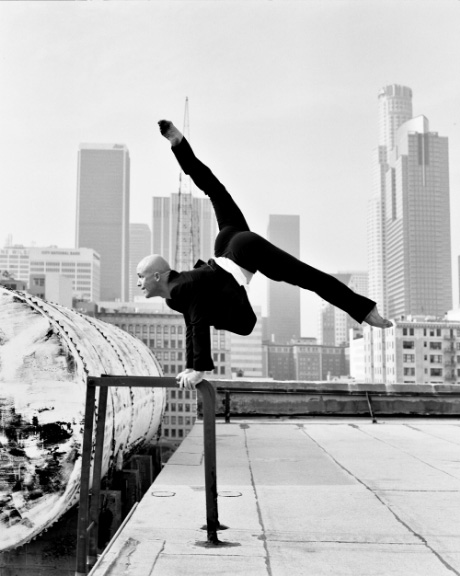The L.A. dance scene of late has felt a fresh momentum. And the decade-long accumulation — of new companies, new venues, new academies and institutions, prestige teachers and choreographers — took a leap in cumulative power this past month, thanks to the debut of an elegant digital source called Dance Map L.A.
Simple census taking can be a powerful tool on its own, but this video-rich interactive website and mapping tool has been reenergizing a community and serving as a catalyst for important conversations about innovation and invention in L.A. dance.
The project culminates 7 years of investigation into digital and multi-media journalism conducted by Dance Map L.A. project director Douglas McLennan and executive producer Sasha Anawalt, Director of USC Annenberg Masters School of Arts Journalism. With a grant from the Doris Duke Foundation, the duo first created three iterations of pop-up newsrooms covering arts and culture events at a time when city newspapers had cut critics from the payrolls. “The question was: ‘How can we ride out this storm,” Anawalt explains. “And not only ride it out, but actually defy the storm and shape the future?”
Data collection and visualization became a key way to “make a topic more visible,” McLennan says. “Dance Map L.A. is…the first iteration of making a community visible.” ‘Visibility is power’ is in fact the tagline of the site. (Full disclosure: McLennan is also the founder of Artsjournal.)
To “engage” users with the survey, McLennan conceived of a visual display of responses that he calls ‘these interactive donuts….As soon as you add your answer it shows where you stand in the mix of all of this,” he explains. “What’s great about it I think is that it kind of spurs you to take a look at the next one and the next one and answer them because you can see where you are in relationship to everybody else,” he continues. Other incentives include the opportunity for survey takers to enter into a giveaway for theater tickets and four $250 grants.
During the survey period — launched Feb. 13 and slated to close on April 6 [now extended to June 30] — the site attempts a “ three-dimensional view” of the local dance scene, McLennan explains. The question: What does an L.A. dancer look like? is answered by the survey questions. A physical map answers the question: Where is dance taking place around the county? Thirdly, a twitterbot displays popular conversations about dance as culled from articles cited by local and national Twitter users.
Though Anawalt was a prominent L.A. dance journalist before launching her visionary graduate research projects at USC, her devotion to the performing art wasn’t the key reason they chose to study the dance community; originally they planned to map classical music. But they opted instead for a community that “wasn’t massively large” and would have “high impact,” McLennan explains. “When you have a way of measuring yourself and looking against a larger frame,” McLennan says, “the locating yourself in part of that is just such an empowering feeling. Then it starts to spark creative ideas about where you fit in, what you can do, who you can call on, what you can accomplish.” As Anawalt puts it: “Once you’ve taken the survey, you’re in. You’re like part of the team.”
Meeting at LACMA recently, Anawalt says she senses Dance Map L.A. is taking stake of both the current surge in dance activity (“it hasn’t felt this way here since the 1980s”) but also feels its contribution to an overdue reckoning of L.A. dance history (given that the singular Denishawn school, which spawned pioneering Martha Graham, was started here.) “This really is the birthplace of American modern dance,” she says. “Why don’t we celebrate that?”
Pulling up the survey on her laptop, Anawalt identifies that most of the early respondents, citing less than 10K annual income, probably hail from the miserably paid concert dance community — not a full representation of a community so rich with film and video dancers, street artists, immigrant groups and more, Anawalt knows.
To bring in the broadest possible respondent base, she is bracketing the survey dates with get-togethers for the city’s dance community, a practice initiated by Kristy Edmunds at CAP-UCLA last year when she pulled government, educational and institutional dance mailing lists and sent unexpected invites for the whole community to attend a free performance of the Batsheva Dance Company. In February, Anawalt partnered with Edmunds to host a launch party for DanceMapLA at Royce Hall, where video of local dancers in motion was projected hugely onto the wall (and later turned into a promo film). “Kristy Edmunds and CAP UCLA magnified us, literally,” Anawalt says.
Examining the day’s survey numbers, 500 respondents and counting, Anawalt reads: “How often do you attend dance performances? How much time do you spend time watching dance online?” She shakes her head at the low percentage of YES answers. “I think that’s crazy…they are not taking advantage of online. They’re not doing video; they are not going to see each other’s work; they do not have agents representing them; they do not get together on a regular basis; they’re very fractured and there isn’t a sense of community.”
Yet even when the responses are discouraging, the data collection cannot help but excite her. “It’s up to the journalists to take this information and build a story from it,” she says. “ Interview people. Find out what’s really going on. Watch this as it changes.” (A few days after we spoke, seeking the younger/professional demographic, Anawalt was queued up alongside those auditioning for “So You Think You Can Dance.”)
Though Anawalt has no question that only an institution like USC Annenberg could have tackled the legal hurdles to launch the site, “surveys are both a science and an art,” she says, she’s unclear about its best future home. Since the Duke grant is over, there are no funds to sustain or grow the site, plus — more crucially — the data now feels more central to a dance service organization or union than a journalism program.
Yet there is no obvious handoff organization. LA. lacks a robust centralized physical hub like San Francisco’s ODC, though there are smaller, enduring entities like the Dance Resource Center (offering members, mostly indie modern dancers, financial sponsorships via use of their non-profit 501(c)3 status) and Career Transition for Dancers, which provides career counseling and grants to the more professional, union dancers. Both organizations are prioritizing efforts to connect with L.A.’s wide range of heritage-based dance companies, which often remain unaffiliated. As DRC director Alex Mathews explains: “Companies that derive from local communities, immigrant groups, grass root schools or cultural heritage postures…do not always feel welcome in the traditional system. For some, it wouldn’t occur to try.”
The Manhattan-based dance service organization Dance NYC conducted their own dancer survey in 2010, one of the inspirations for Dance Map LA. At Dance NYC, which functions as the city’s essential cyberspace hub, what began as youth initiative (their survey was aimed at 20-35 year olds) morphed into a diversity-oriented initiative as they realized that big swaths of the city were not learning about the survey or could not easily respond. Survey creator Julia Kelly explains, “Dance NYC proceeded to look at what the trouble spots for each demographic were and tried to figure out whether there was anything that service organizations could do to help.” And while incomplete in parts, the collected data has improved their ability to lobby and fundraise, Kelly explains. We can say: “Look how spread out we are and look how many of us there are and how your dollars belong in our programs,” she says.
Bonnie Oda Homsey, director of the Los Angeles Dance Foundation, concurs the same funding push could happen in L.A. “The issue is making a compelling case to the foundations or public agencies to recalibrate the levels of funding allocated to dance,” she says. “Dance Map LA is among the indicators that can help make the case.”
In the meantime, over 500 dancers have taken the L.A. survey at this point. McLennan sees greater possibilities of engagement there, too, if an entity were to build it out further and maintain it. “Originally I wanted to build it out so you could really sort of almost look inside the buildings around you and find out where things are going on… Each of the things on this project are rudimentary now, but I think that they suggest some ways of starting to coalesce communities.”
McLennan explains, “When you get in some [online] communities that function really well you get a hierarchy — the more you use it, the higher you go up in the hierarchy, people become obsessive about that…It makes it a really good way to motivate people to behave within a community in ways that you would like them to do.”
“Not in a coercive kind of way,” he adds quickly. “But in a way that helps to build and strengthen the community. If for example L.A.’s dance community is so spread out and it’s difficult to get people to rally around particular efforts, maybe there are ways that this kind of thing can help coalesce people around behavior that helps.”
Take the survey now, before its slated end date of April 6. And check the LA Dance Festival roster for a DanceMapLA celebration party.
[A version of this article originally ran on Artbound.]




There are not nearly enough respondents to draw any real conclusions. This strikes me as a mostly pointless exercise with mostly academic appeal. We already know what influences dance and audiences: real dance companies dancing exceptional proprietary choreography, and producers who bother to lift those companies out of the demeaning and over saturated black box/studio concert context by presenting them in real theaters.